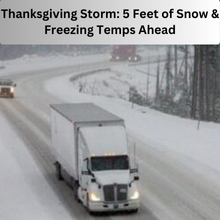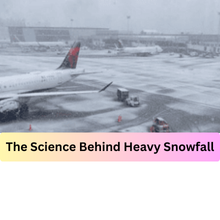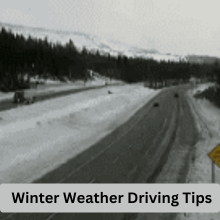Thanksgiving is a time for family, food, and travel. However, this year’s post-Thanksgiving travel could be impacted by one of the most powerful winter storms of the season. The National Weather Service (NWS) has issued severe warnings for 11 states as a storm system brings heavy snow, bone-chilling temperatures, and high winds. Millions of Americans are expected to hit the roads and skies after the holiday, but the storm could disrupt travel plans and cause dangerous conditions across the Northeast and Great Lakes regions. If you’re planning to travel, it’s important to be prepared for whatever Mother Nature has in store.
The Powerful Winter Storm
This upcoming winter storm isn’t just a little snow shower; it’s a full-blown weather event that will affect millions. The storm will bring a combination of heavy snow, frigid temperatures, and strong winds across the northern and northeastern United States. States such as Wisconsin, Michigan, New York, and Maine are expected to bear the brunt of the storm, which could bring up to five feet of snow in some areas. The storm will begin on November 29 and continue through the holiday weekend, with weather conditions worsening each day.
Weather Alerts from the National Weather Service (NWS)
The National Weather Service is already sounding the alarm about the severity of this storm. Winter storm warnings, advisories, and watches have been issued across large parts of the country. In these areas, travelers can expect dangerous driving conditions, icy roads, and heavy snow. Winter storm warnings indicate that significant, hazardous weather is expected, while winter weather advisories suggest less severe conditions that still require caution.
The NWS advises travelers to stay informed by checking updates regularly. The forecasts are constantly changing as the storm evolves, so it’s important to have up-to-the-minute information.
States Affected by the Winter Storm
The storm will impact 11 states, mainly in the northeastern and Great Lakes regions. Here’s a breakdown of the states at greatest risk:
- Wisconsin: Expect heavy snow and freezing temperatures.
- Michigan: High winds and snow accumulations up to three feet in some areas.
- Indiana: Snowfall will make driving dangerous, especially on major highways.
- Ohio: Icy roads and strong winds could lead to travel delays.
- West Virginia: Power outages are a concern, especially in mountainous regions.
- Pennsylvania: Snow, sleet, and freezing rain are expected.
- New York: The state will experience heavy snow and strong winds, particularly in upstate areas.
- Massachusetts: Coastal areas will face snow and icy rain.
- Vermont: A significant amount of snow is expected, leading to hazardous travel.
- New Hampshire: Snowfall could accumulate quickly, causing disruptions.
- Maine: The storm will bring heavy snow, with blizzard conditions possible in some areas.
Understanding the Winter Storm
The winter storm that’s expected to roll in after Thanksgiving is no ordinary weather event. As millions of people hit the roads and airports, a massive system is set to bring significant snowfall and bitterly cold temperatures across much of the United States. While snow is common in many areas this time of year, this storm is forecasted to be especially intense, with some regions bracing for up to five feet of snow.
The National Weather Service’s Role in Alerts
When winter weather strikes, the NWS is the go-to source for timely updates and warnings. These alerts help people make informed decisions, whether they’re planning travel, protecting their homes, or ensuring their families are safe. The NWS issues a range of warnings, from Winter Weather Advisories to Blizzard Warnings, and they’re critical for staying ahead of dangerous conditions.
Regions at Risk: Northeast and Great Lakes
Several regions are in the storm’s direct path, particularly the Northeast and Great Lakes. States like Michigan, Wisconsin, New York, Ohio, and Massachusetts are expected to be heavily impacted. Major cities such as New York, Boston, and Chicago are bracing for hazardous driving conditions, with high snow accumulations and freezing rain expected. Travelers should expect disruptions in these areas, especially along major highways and at airports.
The Science Behind Heavy Snowfall
How does such an intense storm develop? The formation of heavy snow is driven by cold air meeting moist weather systems. The NWS Climate Prediction Center suggests that this particular storm is driven by a broad area of low atmospheric pressure, which brings an unusual combination of heavy snow and low temperatures. Meteorologists have accurately predicted the path of the storm, using advanced weather models to track and measure snowfall in real time.
Cold Temperatures and Wind Chill Warnings
It’s not just the snow that will pose a danger. The storm will bring record-low temperatures, with some areas seeing the mercury drop below -10°F (-23.33°C). As these cold temperatures combine with high winds, wind chill factors could make it feel much colder. Travelers should be aware of the dangers of frostbite and hypothermia, especially if caught outside for long periods.
Winter Storm Warnings in 15 States
The storm doesn’t just affect the snow-heavy Northeast. Winter storm warnings have been issued for 15 states across the country. The NWS is tracking conditions in areas like California, Nevada, and even Idaho, where the storm’s icy grip could impact areas not typically prone to harsh winter conditions. These warnings indicate that travelers across a wide range of regions should stay alert and prepared.
Also read: Mega Millions Jackpot for Nov. 22, 2024: Did Anyone Win?
How to Prepare for a Winter Storm
Proper preparation is key when facing any winter storm. Here’s a checklist to help you prepare:
- Home Safety: Make sure your heating system is working, and insulate pipes to prevent freezing. Consider having extra blankets, water, and canned food on hand.
- Car Safety: Keep your car stocked with emergency supplies, including blankets, a flashlight, and non-perishable snacks. A full tank of gas will prevent you from getting stranded.
- Winter Gear: Dress in layers, and keep a scarf, gloves, and a hat handy when going outdoors.
Impact on Travel: Roads, Airports, and Flights
Travelers across the Northeast and Midwest should brace for major disruptions. Interstate highways like I-90, I-94, and I-80 are expected to be covered in snow and ice, leading to significant delays. If you’re flying, expect long lines at airports and possible flight cancellations or reroutes. Snowstorms, freezing rain, and low visibility make it difficult for planes to take off or land safely.
Travel Disruptions: What to Expect
What’s the real impact of this storm on travel? Well, millions of people are expected to experience disruptions, from highway closures to flight cancellations. It’s essential to check the latest weather reports and make alternate plans if necessary. If you’re traveling during this time, expect delays and have a flexible schedule in case you need to adjust.
Winter Weather Driving Tips
Driving in winter conditions is always a challenge, but it becomes even riskier during a major snowstorm. If you must drive, make sure you:
- Slow Down: Allow extra time for your journey and reduce speed on icy roads.
- Keep Distance: Give yourself plenty of space from other vehicles.
- Avoid Sudden Movements: Be gentle with braking and acceleration to prevent sliding.
Power Outages and Other Hazards
Heavy snow and freezing rain pose a serious risk to power lines. Many areas could experience localized power outages due to fallen trees or ice accumulation. If you lose power, remember to use flashlights rather than candles, and avoid opening your refrigerator to preserve food. Have a backup source of heat if possible, and keep emergency numbers handy.
Local Authorities’ Efforts to Manage the Storm
Local authorities are taking steps to ensure the safety of citizens, including clearing roads and providing emergency services. Snowplows and salt trucks will be deployed to keep highways passable. Still, with such a massive storm system, expect some delays in response times. Stay tuned to local news for updates on road conditions and closures.
Also read: Shocking: First U.S. Child Diagnosed with Bird Flu in California
Conclusion
With Thanksgiving just around the corner, this winter storm is a serious reminder of the challenges posed by winter weather. Heavy snow, freezing temperatures, and high winds are all expected to disrupt travel plans. The key to staying safe is preparation. Keep an eye on weather alerts, check road conditions, and make sure you’re ready for any delays. Safe travels and stay warm this holiday season!
FAQs
-
How much snow is expected in different areas?
- Snowfall could reach up to five feet in some areas, particularly in the Northeast and Great Lakes.
-
What is the best way to check for travel disruptions?
- Stay updated with real-time alerts from the National Weather Service, local news, and major travel apps.
-
How do I prepare my car for a winter storm?
- Ensure your car is stocked with emergency supplies and check your tires and battery.
-
Are power outages expected in urban areas?
- While rural areas are at higher risk, urban areas could also experience localized outages due to freezing rain.
-
How does the National Weather Service issue alerts?
- The NWS uses advanced weather monitoring tools to issue warnings based on real-time data on snow, ice, and temperatures.


